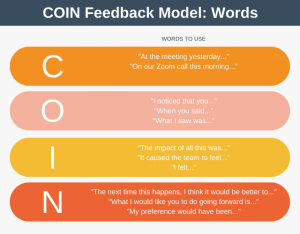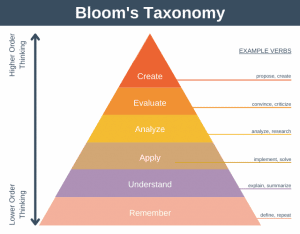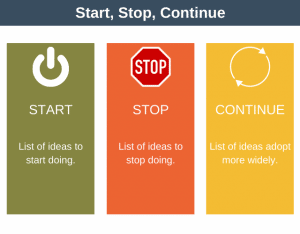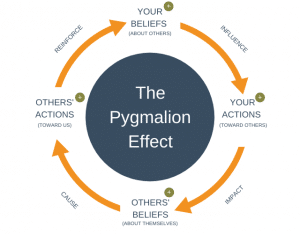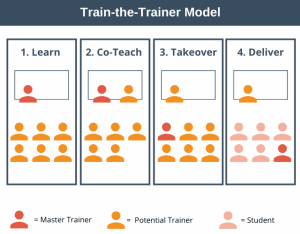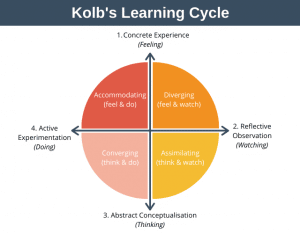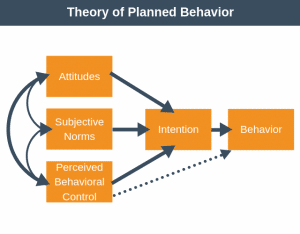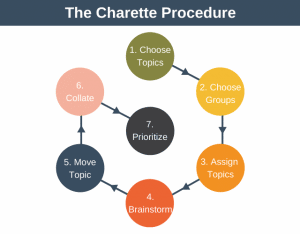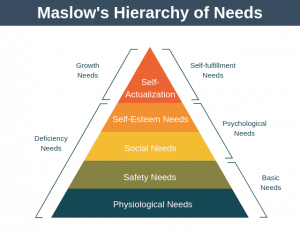Since the beginning of industrialization and the advent of factories, people have been trying to figure out what motivates employees.
One of the very first theories was developed by Frederick Taylor, who wrote, “The Principles of Scientific Management” in 1911.
More recent theories of motivation include ERG Theory (1972) by Alderfer and the Equity Theory of Motivation (1963) by Adams.
Unfortunately, most of the theories of motivation differ in what they think the best way to motivate employees is.
The reason the theories draw different conclusions is that motivation is somewhat of a black box, where it’s difficult to see what’s going on inside our heads, and each of us is unique enough to make it very difficult to draw anything other than very general conclusions.
Theories of Motivation
In a general sense, you can think of motivation as working as follows:

As you can see, each of us has needs. Your needs will be different from my needs. But each of us is motivated by our needs to exhibit certain behaviors. The aim of our behaviors is obviously to meet our needs.
Whether our needs are satisfied or not can then cause us to change our needs. In this way, the cycle begins again with our new needs, potentially causing us to exhibit new behavior.
Content Theories vs. Process Theories
As we’ve already discussed, there are many different theories of motivation in existence, and each of them is different. However, they can be categorized into two groups, known as Content Theories and Process Theories.
1. Content Theories
Content theories are also sometimes called needs theories. They look at motivation from the perspective of our needs and aspirations. The theories then discuss motivation in terms of filling these needs.
You can think of content theories of motivation as focusing on WHAT will motivate us.
The main content theories of motivation are – Maslow’s Hierarchy of Needs, Alderfer’s ERG Theory, McClelland’s Three Needs Theory, Herzberg’s Two Factor Theory, and McGregor’s Theory X and Theory Y.
2. Process Theories
Process theories look at how people are motivated. They are concerned with the process by which motivation occurs, and how we can adjust our processes to alter motivation levels.
You can think of process theories of motivation as focusing on HOW motivation occurs.
The main process theories of motivation are – Skinner’s Reinforcement Theory, Vroom’s Expectancy Theory, Adam’s Equity Theory, and Locke’s Goal Setting Theory.
The diagram below shows how the different motivation theories fit within the scheme of things.
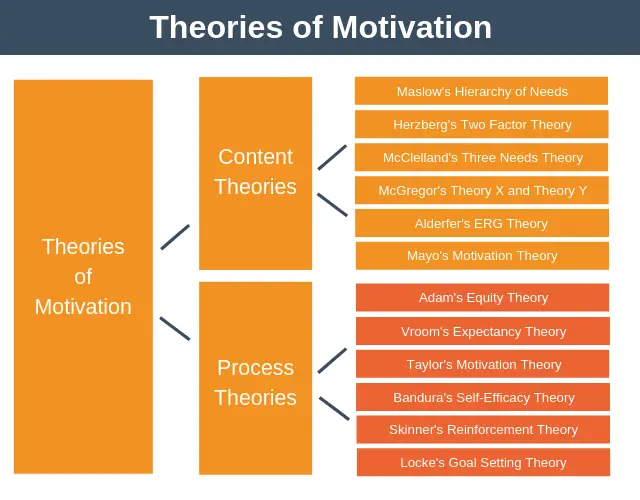
Let’s now give a brief overview of each of these theories of motivation. If you’d like to dig deeper, then we have provided links to an article covering the theory in greater depth.
1. Maslow’s Hierarchy of Needs
Maslow described needs in terms of a hierarchy. The concept being that needs at the bottom of the hierarchy must be satisfied before an individual can move to the next level and seek to satisfy those needs.
Now, each individual’s needs are changing all the time, but at any time, an employer can use the hierarchy to try and determine what is going to motivate an employee.
The five levels of the hierarchy are:
- Physiological needs: such as food and water.
- Safety needs: such as being free from war, natural disasters, and having job security.
- Social needs: such as having relationships and belonging to groups.
- Esteem needs: such as receiving praise, recognition, and status.
- Self-actualization needs: such as wanted to be the best we can be.
When using Maslow’s Hierarchy of Needs, a business should offer different rewards to encourage employees to keep moving up the hierarchy. This will keep employees motivated.
2. Herzberg’s Two Factor Theory
Herzberg argued that there are two factors which are essential in the motivation of employees. These are motivators and hygiene factors.
- Motivators: these encourage employees to work harder if present. Examples of motivators include having an interesting job, advancement, and growth.
- Hygiene factors: These don’t encourage employees to work harder, but they will cause them to become unmotivated if they are not present. Examples of hygiene factors include working conditions and remuneration.
Herzberg’s Two Factor Theory believed that to motivate employees, employers should:
- Eliminate job hygiene stressors: remove those things that are causing poor job satisfaction, for example, poor working conditions.
- Boost job satisfaction: through job enrichment (making the job more interesting by giving it more complex tasks) and job empowerment (making the post more satisfying by giving it a greater variety of functions).
- Empower employees: by delegating increasing responsibility to each employee.
3. McClelland’s Three Needs Theory
McClelland’s Three Needs Theory argues that each of us has three needs to a greater or lesser extent. The three needs are:
- Need for achievement: for example if you are motivated by setting a new record, or by the opportunity to get promoted.
- Need for affiliation: for example if you are motivated by collaborating with others or being accepted as part of a group.
- Need for power: for example if you are motivated by being in charge of others, or if you are motivated by having high status.
Some people live at the extremes for each of these needs. For example, a team member with no need for power might be subordinate and overly dependent, whereas a team member with too much need for power might exaggerate their own abilities.
Managers can use the Three Needs Theory to set motivational targets tailored to each member of their team.
4. McGregor’s Theory X and Theory Y
McGregor’s Theory X and Theory Y puts employees into two broad categories.
a. Theory X
Theory X assumes that team members are intrinsically lazy and unmotivated, and will avoid doing work if any opportunity presents itself.
Because of this, management must work tirelessly and continually to build systems of control and supervision over employees.
b. Theory Y
Theory Y assumes that team members are ambitious and self-motivated. A Theory Y manager holds the view that if provided with the right conditions, team members will perform well.
McGregor himself was in favor of adopting a Theory Y style of management in most cases. Employers looking to use Theory Y might:
- Use job enlargement to increase job satisfaction.
- Use a collaborative style of management, so employees feel they are a crucial part of decision making.
- Set targets that encourage employees to challenge themselves.
5. Alderfer’s ERG Theory
You can think of the ERG Theory of Motivation is being a simplified version of Maslow’s Hierarchy of Needs.
In ERG Theory, there are three needs which are also arranged in a hierarchy.
- Existence needs: These needs concern your physical well being. These are needs, such as food, water, and feeling safe.
- Relatedness needs: These needs concern your need to relate to other people. They are needs, such as the need to have positive interactions with others.
- Growth needs: These needs refer to our personal development needs and desire to perform meaningful work. For example, an exciting job with lots of small growth opportunities every day to learn something new will tend to keep us motivated.
There are a couple of differences to Maslow’s Hierarchy of Needs.
Firstly, you can pursue multiple needs at the same time. Secondly, if a higher level need is not satisfied, then you may regress and seek to meet lower level needs further.
6. Adam’s Equity Theory
Adam’s Equity Theory of Motivation proposes that high levels of employee motivation in the workplace can only be achieved when each employee perceives their treatment to be fair relative to others.
If you earn half what your colleague earns but do precisely the same work what will you do? Adam’s suggest that you will adjust your inputs (the amount of work you do) to compensate for the perceived unfairness of receiving half the pay (output).
In a nutshell, Adam’s says that as an employee, you’ll compare yourself to others and try to make things fair as you perceive them. As an employee, you can’t change your outputs (your pay and benefits), so you’ll adjust your inputs by either working harder or less hard to make things fair.
According to Equity Theory, there are several ways an employee will assess their situation:
- By considering their experience within their current organization.
- By examining their experience within their previous organization.
- By comparing themselves to others in their current organization.
- By comparing themselves to others outside of their current organization.
7. Vroom’s Expectancy Theory
Expectancy Theory states that a person will choose their behavior based on what they expect the result of that behavior to be.
According to Expectancy theory, the behavior you choose will always be the one that maximizes your pleasure and minimizes your pain.
For an employee to be motivated, the following three factors must be present:
- Expectancy: The belief that if you put the effort in it will be possible for you to hit your targets.
- Instrumentality: The belief that you will receive a reward if you hit your targets.
- Valence: You must value and want the prize on offer.
You can determine the motivation level of any employee by multiplying expectancy, instrumentality, and valence. The higher the result, the higher the motivation.
8. Taylor’s Motivation Theory – Scientific Management
Taylor’s Scientific Management was one of the first motivation theories.
Taylor’s theory can be broken down into two parts.
- A Theory about how employees behave.
- Principles to maximize efficiency based on this theory.
Taylor believed employees were only motivated by one thing, money.
Because workers are only motivated by money, then they don’t inherently enjoy work. Because of this, employers should monitor workers closely to ensure they are not slacking.
Based on his philosophy that employees are lazy, Taylor’s principles boiled down to the following:
- Study employee’s jobs so they can be broken down into manageable parts.
- Describe each component in an efficient, repeatable way.
- Train each employee to perform the task in this new efficient way.
- Use piece rate pay to encourage employees to be productive.
9. Bandura’s Self-Efficacy Theory of Motivation
The Self-Efficacy Theory of Motivation is a task-specific way of thinking about motivation.
The higher your self-efficacy, the greater your belief that you can perform a specific task.
This is important to motivation because people with low self-efficacy are unlikely to give their full effort to a task.
Four factors combine to determine a person’s self-efficacy for a task:
- Experience: If you have performed a similar job previously, then you are more likely to be confident in your ability next time.
- Vicarious experience: You can develop self-efficacy by watching others complete a task.
- Social persuasion: Encouragement from others will increase your self-efficacy. Discouragement from others will have the opposite effect.
- Physiological feedback: When you perform a task, your body will provide physiological feedback. How you interpret this feedback feeds into determining your self-efficacy. Typically, the more at ease you are with a type of task, the higher your self-efficacy.
10. Skinner’s Reinforcement Theory of Motivation
Skinner’s Reinforcement Theory of Motivation tries to explain what motivates good and bad behavior in the workplace.
According to the theory, there are four factors which influence motivation with a schedule. The four elements are levers, which can be used to change motivation levels. They are:
- Positive reinforcement: is a reward you give an employee when they exhibit the desired behavior.
- Negative reinforcement: is a reward you provide an employee by removing something negative from their environment.
- Punishment: Is when you use the threat of negative consequences to stop undesirable behavior.
- Extinction: Extinction refers to stopping someone’s learned behavior. You can extinguish a behavior by withholding the positive reinforcement that led to that behavior in the first place.
You may have noticed that we mentioned that these levers happen within a schedule. This means that reinforcement of behavior needs to be more than a single event. It needs to happen over and over again until the desired behavior is established.
As a manager, using Skinner’s Reinforcement Theory of Motivation can help you to encourage good behavior and discourage undesirable behavior.
11. Mayo’s Motivation Theory
Mayo’s Theory of Motivation is based on the belief that two factors influence motivation in the workplace:
- Job content: the tasks that make up your job.
- Social relations: how you get on and interact with your peers.
Mayo acknowledged that pay and environmental factors play a role in employee motivation, but he believed that relational factors played an even more significant role.
Mayo believed that it was the group that influenced productivity. The importance of the group cannot be overstated. It is the group that determines productivity, not pay, and not processes.
Mayo determined how well a group would perform in terms of two factors:
- Norms: Refers to whether the members of the group encourage positive or negative behavior.
- Group cohesiveness: The comradery of the group. Effectively, how well the group gets along with each other.
Groups that have high cohesiveness and positive norms will be the most highly motivated and therefore highest performing. Conversely, groups with negative norms and weak group cohesiveness will be very unmotivated.
Mayo is important because he was the first to recognize that if you treat an employee well, they might be more productive for you. These days that might seem like an obvious statement, but in the time of Mayo, it wasn’t.
12. Locke’s Goal Setting Theory
Locke’s Goal Setting Theory of Motivation is based on the premise that if you set the right goals, then you can increase both motivation and productivity.
So, what are the right goals?
To be the right goals, goals must have five characteristics:
- Clarity: To be motivating a goal must be clear.
- Challenge: To be motivating a goal must be challenging but not too challenging.
- Commitment: To be motivating, you must be committed to achieving your goal.
- Feedback: You must receive regular feedback or a goal will not continue to motivate you over the long term
- Task complexity: To motivate you, a goal must not be too complicated.
Locke believed that goal setting could be a powerful tool in motivating your team, and yourself, to high performance. He also found that badly set goals, such as a target that is entirely outside of your control, can be demotivating.
Theories of Motivation: Summary
Theories of motivation attempt to explain how to motivate employees in the workplace.
Broadly speaking, theories of motivation fall into two categories: process theories and needs theories.
Process theories look at how people are motivated. They are concerned with the process by which motivation occurs, and how we can adjust our processes to alter motivation levels.
Content theories are also sometimes called needs theories of motivation. They look at motivation from the perspective of our needs and aspirations. The theories then discuss motivation in terms of filling these needs.
